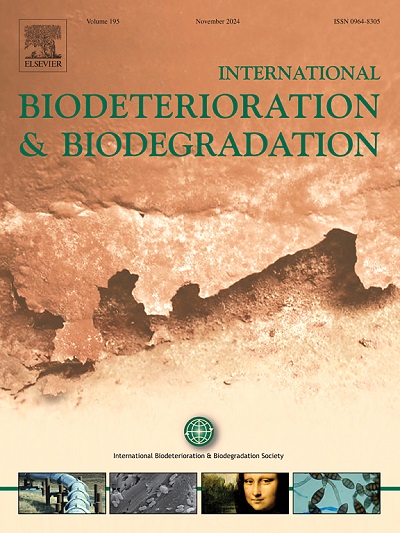Degradation and conversion of organics in a continuous HNAD system treating incineration leachate
IF 4.1
2区 环境科学与生态学
Q2 BIOTECHNOLOGY & APPLIED MICROBIOLOGY
International Biodeterioration & Biodegradation
Pub Date : 2025-03-24
DOI:10.1016/j.ibiod.2025.106073
引用次数: 0
Abstract
The anaerobically treated incineration leachate contains high-strength ammonium and refractory organics, which is advisable to be biologically treated via heterotrophic nitrification-aerobic denitrification (HNAD) process. However, it is still unknown how the organics in leachate wastewater are degraded and utilized during HNAD process. In this study, a continuous HNAD based moving bed biofilm reactor was operated with actual anaerobically treated incineration leachate as the influent. During stable operation, besides superior nitrogen removal efficiency (88.73 %), the organics were effectively removed with a high average COD removal efficiency (85.05 %). Organic fluorescent spectra showed humic substances were significantly removed, with the intensities of the humic peak and fulvic peak decreasing by 96.59 % and 91.93 %, respectively. Furthermore, most of the dissolved organic matter within varying ranges of molecular weight could be degraded during the HNAD process, during which the benzene-based substances were removed and the medium-long chain alkanes (C > 12) were generated. Through carbon balance analysis, assimilation metabolism accounted for 44.75 % of the conversed organic carbon. According to the decrease in respiration inhibition rate from 52.21 % to 25.36 %, the toxicity of leachate wastewater was strongly reduced after treatment by HNAD process. Halomonas (43.72 %) was the dominant HNAD bacteria, and relative abundances of genes associated with refractory organics degradation were increased during the treatment of incineration leachate. These results provide new insights into carbon metabolism during HNAD process for treating wastewater with complex organics.

连续HNAD系统处理焚烧渗滤液中有机物的降解和转化
厌氧处理后的焚烧渗滤液中含有高强度铵盐和难降解有机物,宜采用异养硝化-好氧反硝化(HNAD)工艺进行生物处理。然而,在HNAD过程中,渗滤液废水中的有机物是如何被降解和利用的尚不清楚。本研究以实际厌氧处理后的焚烧渗滤液为进水源,采用连续式HNAD移动床生物膜反应器运行。在稳定运行过程中,除氮去除率达88.73%外,有机物的去除率较高,平均COD去除率达85.05%。有机荧光光谱显示,腐殖质物质被显著去除,腐殖质峰和黄腐质峰的强度分别下降了96.59%和91.93%。此外,在HNAD过程中,大部分不同分子量范围内的溶解有机物都可以被降解,其中苯基物质被去除,中长链烷烃(C >;12)生成。通过碳平衡分析,同化代谢占转化有机碳的44.75%。从呼吸抑制率从52.21%下降到25.36%来看,经HNAD处理后的渗滤液废水毒性明显降低。盐单胞菌(43.72%)是HNAD的优势菌,焚烧渗滤液处理过程中难降解有机物相关基因的相对丰度增加。这些结果为HNAD处理复杂有机物废水过程中的碳代谢提供了新的认识。
本文章由计算机程序翻译,如有差异,请以英文原文为准。
求助全文
约1分钟内获得全文
求助全文
来源期刊
CiteScore
9.60
自引率
10.40%
发文量
107
审稿时长
21 days
期刊介绍:
International Biodeterioration and Biodegradation publishes original research papers and reviews on the biological causes of deterioration or degradation.

 求助内容:
求助内容: 应助结果提醒方式:
应助结果提醒方式:


